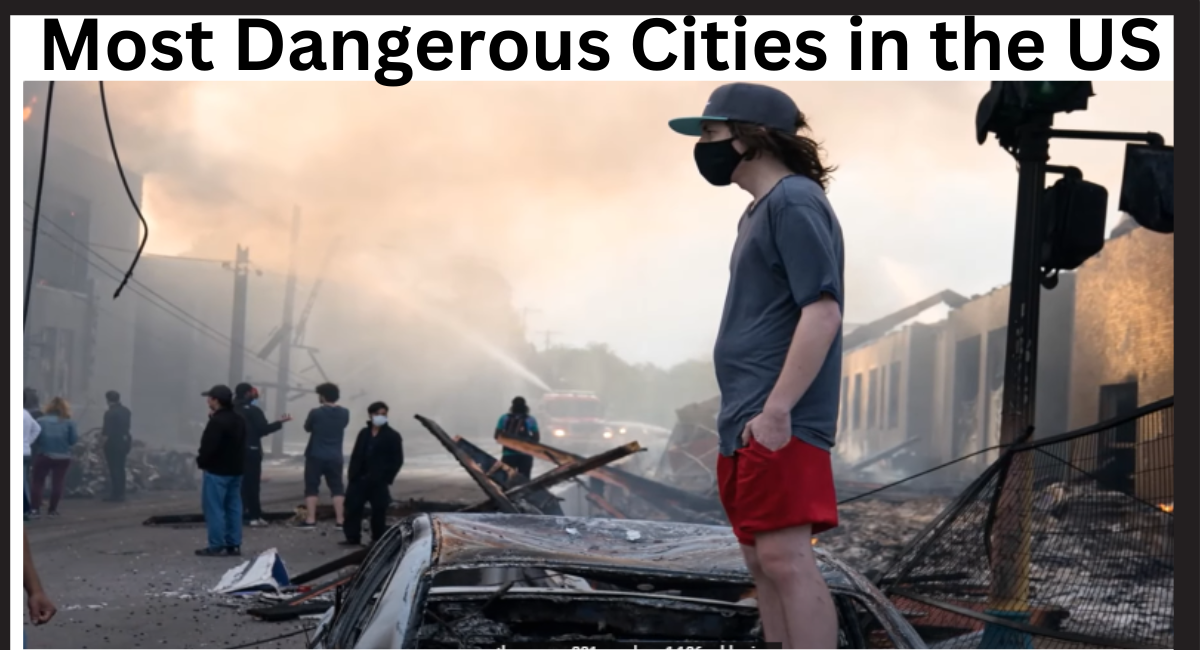Top 11 Most Dangerous Cities in the US in 2024
Which cities in the USA will be most vulnerable to crime in 2024? People all around the nation are concerned about safety, whether they are citizens looking for protection in their everyday lives or tourists trying to visit new places fearlessly. One question comes to light when we examine the most recent statistics: which US cities have gained the dubious distinction of being named the most dangerous?
Understanding the risk environment is crucial for making well-informed decisions about where to live, work, or visit, whether in busy urban areas or peaceful suburban areas. Explore the list of the most dangerous cities in the US as we shed light and investigate the causes of their high crime rates.
Also Read: Most Corrupt States in the USA
A List Of USA’s Most Dangerous Cities
Are you interested in discovering which American cities rank among the top eleven most harmful? These cities have earned their place on the list due to various crimes, including gang violence and property theft. Let’s have a look:
- Detroit, Michigan
- Baltimore, Maryland
- St. Louis, Missouri
- Oakland, California
- Memphis, Tennessee
- Birmingham, Alabama
- Cleveland, Ohio
- New Orleans, Louisiana
- Atlanta, Georgia
- Chicago, Illinois
- Kansas City, Missouri
1. Detroit, Michigan
Detroit, Michigan, maintains a notorious reputation for its enduringly high rates of violent crime. Consistently ranking among the nation’s most dangerous cities, Detroit’s violent crime index, encompassing homicides, robberies, and aggravated assaults, remains alarmingly elevated. It has an estimated violent crime rate of 2,970.1 per 100,000 residents.
The correlation between economic decline and crime rates is evident within Detroit’s socio-economic fabric. Historical challenges, including deindustrialization and population decline, have contributed to a surge in criminal incidents. Heightened levels of unemployment and poverty create fertile ground for criminal behavior.
Detroit’s landscape bears witness to significant urban decay, with abandoned structures and neglected neighborhoods serving as breeding grounds for criminal activities. Spoiled areas attract illicit enterprises, perpetuating cycles of crime and decay and fostering a pervasive sense of hopelessness among residents.
Despite these challenges, collaborative efforts are underway to rejuvenate Detroit and combat crime. Urban renewal projects aim to reclaim abandoned properties and transform neglected areas into vibrant communities. Investments in education and vocational training programs offer pathways out of poverty, while community-oriented policing strategies prioritize trust and cooperation to foster safer neighborhoods.
2. Baltimore, Maryland
Baltimore, Maryland, struggles with persistently high homicide rates, consistently earning its place among the most dangerous cities in America. The city’s alarming number of annual homicides casts a sad shadow over families, communities, and the overall sense of safety within Baltimore.
Drug-related violence significantly compounds Baltimore’s crime woes. Positioned near major drug trafficking routes and entrenched in a history of drug addiction, the city fosters an environment ripe for violence. Rival drug factions frequently clash over territory and control, resulting in shootings, homicides, and innocent casualties caught in the crossfire. The drug trade not only fuels violence but also worsens broader social issues like poverty and addiction, perpetuating Baltimore’s crime cycle.
Overcoming historical tensions between law enforcement and the community is pivotal in addressing Baltimore’s crime epidemic. Past incidents of police brutality and misconduct have eroded trust, hindering effective crime prevention and investigation. Building bridges through community policing initiatives aims to cultivate better communication and collaboration between law enforcement and citizens, ultimately enhancing public safety and reducing crime rates.
In the face of daunting crime statistics, Baltimore’s community organizations have emerged as frontline advocates for change. Non-profits, faith-based groups, and grassroots initiatives take proactive measures to create safer environments. By addressing socio-economic disparities, providing targeted support for at-risk youth, and offering rehabilitation programs for individuals entangled in criminality, these organizations strive to break the cycle of crime and foster pathways toward positive transformation. Their efforts epitomize a commitment to community empowerment and the pursuit of alternatives to criminal behavior.
Also Read: Most Rich States in the USA
3. St. Louis, Missouri
St. Louis, Missouri, maintains a troubling distinction as one of America’s most dangerous cities, grappling with persistently high crime rates, particularly concerning violent offenses with a murder rate of 68.18. The pervasive sense of unease among residents underscores the pressing need to address safety concerns within the city.
A multitude of socio-economic factors contribute to St. Louis’s crime woes. High poverty rates, coupled with unemployment and limited access to quality education and healthcare, create fertile ground for criminal activity. Concentrated poverty in specific neighborhoods exacerbates social strains and elevates the risk of criminal involvement. Additionally, lax gun control measures and the widespread availability of firearms further compound the city’s crime challenges.
St. Louis faces an entrenched epidemic of gun violence, with firearms readily accessible amid socio-economic disparities and scarce community resources. The resultant surge in shootings and homicides not only impacts directly involved individuals but also reverberates throughout the wider community. Addressing this multifaceted issue demands a comprehensive strategy encompassing gun control regulations, community intervention initiatives, and efforts to tackle underlying causes of violence.
Of particular concern is the involvement of youth in criminal activities, influenced by factors such as poverty and limited educational opportunities. Meaningful engagement, mentorship programs, and expanded educational and vocational avenues offer avenues to redirect young individuals away from the allure of crime. By investing in the empowerment and prospects of St. Louis’s youth, the city endeavors to forge a path toward a safer and more prosperous community.
4. Oakland, California
Oakland, California, combats consistently high crime rates, solidifying its place among the nation’s most dangerous cities. Violent crimes, including homicides, shootings, and robberies, underscore the pervasive nature of the city’s crime problem, instilling fear and unease among residents.
Gang violence and the thriving drug trade intensify Oakland’s crime landscape, with street gangs engaging in territorial disputes and drug trafficking, perpetuating violence and endangering innocent residents. The drug trade’s spillover effects exacerbate social issues like addiction and poverty.
Oakland’s elevated poverty rates intertwine with its crime dynamics, as economic deprivation fosters criminal behavior. Efforts to address systemic poverty-related issues, including improving access to affordable housing and job training, are essential to breaking the cycle of crime.
Oakland employs community policing strategies to build trust and strengthen relationships with residents. Violence intervention programs and economic revitalization efforts aim to address the root causes of crime and create a safer, more prosperous city for all.
Also Read: Most Corrupt States in the USA
5. Memphis, Tennessee
Memphis, Tennessee, confronts formidable challenges concerning violent crime, with consistent reports of high rates of homicides, for instance, 397 homicides recorded in 2023, assaults, and robberies shaping its reputation as a dangerous locale. The profound impact of these crimes on victims and the broader community underscores the pressing need for robust crime prevention strategies.
The fear of gang activity and drug-related violence looms large over Memphis, with numerous street gangs orchestrating drug distribution and engaging in violent turf disputes. Rivalries within the drug trade sustain a cycle of violence that threatens public safety and permeates the fabric of Memphis society.
Memphis’s struggle with crime intersects starkly with the specter of poverty, inflamed by limited employment opportunities and inadequate access to education and healthcare. Economic desperation and a shortage of viable alternatives compel individuals towards criminal pursuits, necessitating concerted efforts to address systemic socio-economic disparities and break the cycle of crime.
Community-led initiatives emerge as crucial stakeholders in combating the crime scourge. Non-profit organizations, faith-based groups, and engaged citizens collaborate to provide vital support and resources to at-risk individuals. Through mentoring programs, after-school activities, and job training initiatives, opportunities for personal and professional advancement are offered, empowering individuals to escape the grip of crime. Meanwhile, community watch groups and neighborhood associations foster heightened awareness and promote safety across Memphis communities.
6. Birmingham, Alabama
Birmingham, Alabama, fights with significant challenges in its battle against violent crime. The city’s persistently high violent crime index, encompassing homicides, robberies, and assaults, poses a massive threat to the safety and well-being of its residents, necessitating targeted interventions to fortify community security. Birmingham, Alabama, has a violent crime rate of 16.94 and 59.78 property crime rate per 1000 residents.
Birmingham’s crime landscape is deeply intertwined with socio-economic factors, notably poverty, and unemployment. Elevated poverty rates, often synonymous with inadequate access to quality education and healthcare, engender an atmosphere of despair. Individuals trapped in these circumstances may resort to criminality as a means of survival or escape. Addressing the underlying socio-economic disparities is imperative to disrupt the cyclical nature of crime in Birmingham.
Birmingham faces pronounced challenges pertaining to gun violence, worsened by the widespread availability of firearms and socio-economic disparities. The resultant surge in shootings and homicides permeates the community, instilling fear and impeding progress. Addressing gun violence demands a multifaceted approach, encompassing gun control measures, community engagement, and investments in conflict resolution and non-violence initiatives.
Grassroots initiatives and community partnerships underscore Birmingham’s response to its crime quandary. Organizations spanning from grassroots entities to faith-based groups have rallied to implement preventive measures. Through mentorship, educational programs, and support for at-risk youth, these efforts provide viable alternatives to criminal involvement. Collaboration with law enforcement agencies and community policing initiatives aims to foster trust, communication, and collective responsibility for community safety, thus addressing the root causes of crime and cultivating a more secure and vibrant Birmingham.
7. Cleveland, Ohio
Cleveland, Ohio, endures challenges related to crime and public safety, consistently reporting elevated rates across various crime categories, including violent offenses, robberies, and burglaries. Staying abreast of evolving crime trends is imperative to grasp the pressing issues confronting Cleveland residents and to devise effective strategies for crime prevention.
Socioeconomic disparities wield a profound influence on Cleveland’s crime landscape. Elevated poverty rates, coupled with limited educational and healthcare access, foster an environment conducive to criminal behavior. Individuals navigating economic adversity may resort to illicit activities as a means of coping or seeking respite from their circumstances. Prioritizing initiatives aimed at poverty alleviation, educational equity, and healthcare accessibility is paramount to disrupting the cycle of crime in Cleveland.
Cleveland contends with the formidable challenge of drug-related crimes, marked by surges in trafficking and addiction. These issues not only fuel criminality but also worsen social maladies like poverty and familial instability. A holistic approach encompassing law enforcement, education, prevention, and addiction treatment is essential to combat drug-related offenses and bolster Cleveland’s overall safety effectively.
Addressing Cleveland’s crime predicament necessitates concerted collaboration between governmental entities and the community. Law enforcement agencies collaborate closely with community organizations, neighborhood associations, and residents to devise targeted strategies tailored to specific crime hotspots and cultivate trust.
Community outreach initiatives, such as youth mentorship programs and vocational training, provide avenues for at-risk individuals to escape the grip of crime. By fostering a culture of collaboration and shared responsibility, Cleveland endeavors to forge a safer and more secure environment conducive to the well-being of all its residents.
8. New Orleans, Louisiana
New Orleans, Louisiana, grapples with entrenched issues surrounding crime, consistently ranking among the nation’s most dangerous cities. Despite sustained efforts, the city confronts ongoing hurdles in enhancing public safety and curtailing criminal activity.
Following Hurricane Katrina’s devastation in 2005, New Orleans experienced a marked escalation in crime rates. The hurricane’s upheaval, coupled with widespread displacement and societal upheaval, created fertile ground for criminal behavior. This post-Katrina crime wave underscored the urgency for comprehensive strategies to rebuild communities and address the underlying drivers of crime.
Gang-related violence and the illicit drug trade remain significant contributors to New Orleans’ crime landscape. Street gangs vie for control over territory, precipitating violent confrontations and escalating tensions. Additionally, the drug trade perpetuates violence and exacerbates socioeconomic disparities, particularly within marginalized communities. Addressing these challenges demands a multi-pronged approach, integrating targeted law enforcement efforts, community engagement initiatives, and comprehensive rehabilitation programs for individuals trapped in criminal enterprises.
The government of New Orleans has implemented a range of initiatives to bolster safety and combat crime. Law enforcement agencies deploy resources strategically, focusing on high-crime areas and implementing community policing strategies. Moreover, investments in education, social services, and vocational training programs aim to address underlying socio-economic factors contributing to criminal behavior. Collaborative partnerships between governmental bodies, community organizations, and residents play a pivotal role in fostering a safer New Orleans and rebuilding community trust.
9. Atlanta, Georgia
Atlanta, Georgia, deals with significant challenges concerning crime statistics and trends despite recent improvements. Staying informed about these metrics is essential for addressing the specific issues faced by Atlanta residents and developing targeted strategies for crime prevention.
Gang-related activities present a significant challenge to public safety in Atlanta. Various street gangs engage in criminal activities such as drug trafficking, robberies, and violence, contributing to elevated crime rates. Effective gang prevention and intervention programs, along with targeted law enforcement efforts, are crucial for addressing the root causes and consequences of gang-related activities.
Social inequalities exacerbate the crime problem in Atlanta, with disparities in income, education, and access to healthcare fostering an environment conducive to criminal behavior. Reducing crime rates and advancing social fairness depend on addressing these gaps through legislative modifications, affordable housing efforts, educational reform, and job creation programs.
Community-based initiatives play a pivotal role in promoting safety and addressing crime in Atlanta. Collaborative efforts between non-profit organizations, neighborhood associations, and concerned citizens yield impactful programs focused on crime prevention, community engagement, and support for at-risk individuals. These initiatives, ranging from mentorship programs to neighborhood watch initiatives, contribute to a safer and more cohesive Atlanta for all residents.
10. Chicago, Illinois
Chicago, Illinois, fights with persistently high crime rates, persistently ranking among America’s most harmful cities. Recent data shows a significant increase in violent crimes, with a 5.38 crime rate per 1000 residents and a 31.76 property crime rate per 1000 residents. This underscores the urgent need for action to address the city’s crime epidemic.
Gang violence significantly contributes to Chicago’s elevated crime rates, with various street gangs engaged in drug trafficking and territorial disputes. Innocent bystanders often become collateral damage in ongoing gang conflicts, fostering fear and eroding community trust.
Chicago has implemented strategies such as increased law enforcement presence in high-crime areas and community policing to strengthen ties between police and residents. Technology-driven solutions like gunshot detection systems enhance response capabilities.
Residents are taking proactive measures through neighborhood watch programs and non-profit organizations offering youth programs. These grassroots efforts aim to foster safer neighborhoods and drive positive change.
11. Kansas City, Missouri
Kansas City, Missouri, grapples with a complex array of challenges regarding crime rates and statistics. Despite its vibrant urban fabric, the city contends with persistent crime issues that affect its communities and residents. Understanding the nuanced dynamics of crime trends is paramount for developing effective strategies to address these pressing concerns.
Several factors contribute to the crime dynamics in Kansas City, including socioeconomic disparities, gang activity, and substance abuse. These intertwined elements create an environment conducive to criminal behavior, necessitating comprehensive approaches to prevention and intervention.
Gang-related activities present a significant threat to public safety in Kansas City, with various gangs operating within the city. Engaged in illicit activities like drug trafficking and violence, these groups fuel elevated crime rates and pose challenges for law enforcement efforts.
Kansas City authorities have implemented initiatives such as targeted law enforcement operations and community policing programs to address crime. Additionally, collaborative partnerships between law enforcement agencies and community organizations are pivotal in tackling root causes and implementing preventive measures.
Community involvement is vital in combating crime, with residents actively participating in neighborhood watch programs and grassroots initiatives. These efforts empower communities to take ownership of their safety and foster collaboration with law enforcement.
Conclusion
In conclusion, these 11 most dangerous cities in the US face significant challenges concerning crime and public safety. They deal with issues such as high crime rates, gang violence, economic decline, poverty, and social inequalities. However, each city exhibits resilience and a commitment to addressing these issues through various initiatives and collaborative efforts.
By prioritizing community engagement, implementing comprehensive strategies, and investing in socio-economic development, these cities can work towards creating safer, more inclusive, and prosperous communities for all residents.
FAQs
Which American City Has the Highest Rate of Crime?
The city in the US with the highest crime rate is Detroit, Michigan. It leads the list with a notably high violent crime rate for the year 2024, based on an analysis of various violent crimes such as homicide, robbery, and assault.
Which Is the USA’s Most Peaceful State to Live In?
Maine is considered the most peaceful state to live in, followed by New Hampshire and Vermont.
Which States in the US Report the Highest Murder Rates?
The following five states have the highest homicide rates:
- Mississippi
- Louisiana
- Alabama
- New Mexico
- South Carolina
Is It Ok to Live in Alabama?
Alabama offers diverse landscapes and a low cost of living, making it ideal for families. However, cities like Birmingham, Montgomery, and Mobile struggle with high crime rates, including violent and property crimes. Researching neighborhoods and taking safety precautions is recommended if you’re considering living in these areas.
Should I Live in Florida or Alabama?
Choosing between Florida and Alabama comes down to what matters most to you. If you crave a laid-back beach lifestyle, Florida might be the way to go. However, if affordability is key, Alabama’s real estate options might be more appealing. Consider your priorities and preferences carefully before making your decision.

I’m Sophia Jones, an adventurer at heart from New York City, USA. I live for travel and exploration, always eager to discover new places, meet fascinating people, and try out diverse cuisines. Over the past few years, I’ve traveled to numerous countries, immersing myself in different cultures and creating unforgettable memories.






